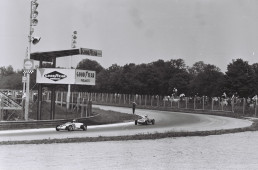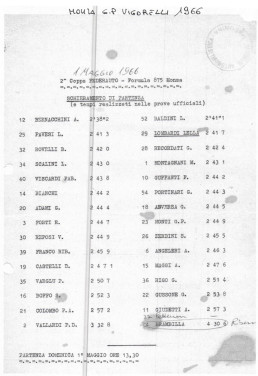I had the opportunity to race with Lella Lombardi in 1966 in the F.875 Monza single-seaters. These races took place both day and night. At Monza and Vallelunga.
This propaedeutic formula certainly did not get drivers used to controlling the big powers. However, it had the notable merit of accustoming the drivers to managing the races, considering the constant presence of groups of cars with whose drivers there was repeated confrontation on the track. Therefore, it was necessary to constantly manage the continuation of the race with lucidity and detatchment even with the great risk of creating accidents, which, moreover, were quite frequent due to some rather exuberant drivers.
These were special single-seaters: they were derived from a Fiat “giardinetta” from which they drew all the essential components. For example, the braking system was considerably oversized in relation to the fact that the single-seater F Monza had a mass of only 400 kg; this meant that it had to be used very carefully when braking at the limit, due to the risk of lock-ups and therefore transforming rolling friction into sliding friction with clearly negative consequences. Also, the power-to-weight ratio was not great, practically one HP per 10 kg of mass, and this implied particular driving care so as not to waste energy in useless drifting or anything else.
I don’t want to dwell too long on technical issues that would be misleading in this case. However, they make us understand that these single-seaters did not perform best with impetuous drivers, but rather with thoughtful drivers accustomed to coolly and professionally resolving all race situations, which were constantly evolving as the laps went on. I would like to point out that Lella had all those characteristics necessary for a driver to have a following in the professional activity, something which then happened to this singular girl, a car driver.


I remember her as a seemingly petite and fragile girl but, in reality, she was a determined person, willing to make motor racing her raison d’être.
Lella was of such an extreme fineness, grace and kindness but, nevertheless, she was stubbornly determined to pursue the goals she had set for herself in spite of the terrible difficulties that such a profession implied and still implies today.
When I saw single-seater No. 29 next to me during the race, I knew it was Lella and that made me very calm because the presence and proximity within a few metres of a driver with the head of a true professional was a reason for me to enjoy the race that was going on under the wheels!
These single-seaters, even back then, were not always anthropometric in their behaviour, so that the drivers’ bodies were subjected to forces that resulted in tension in several areas, e.g. shoulders, arms and back. The best prepared and most responsive drivers were the most ‘athletic’ones and those with perfect mental and neurological systems.

she managed to make it to Formula One, running a dozen races and perhaps more in that category, with the record of being the only woman, in the entire history of the top category, to get a score in the drivers’ world championship and also for this, she entered the history of the Formula One world championship.
Maria Grazia Lombardi, called Lella, now races in the sidereal interspaces of the infinite Universe, but I am sure that wherever on Earth there is a track, a roar of engines and a scent of burning tyres and oil, there dear Lella is present in the memory of a time that was and for which she fought hard and successfully!
Fabrizio Viscardi is a driver who raced F.875 MONZA ALLA VARIANTE JUNIOR – ANNO 1966 SCUDERIA JOLLY CLUB MARIO ANGIOLINI, a race in which Lella Lombardi was also present.


